new posts in all blogs
Viewing: Blog Posts Tagged with: Latina performance, Most Recent at Top [Help]
Results 1 - 7 of 7
How to use this Page
You are viewing the most recent posts tagged with the words: Latina performance in the JacketFlap blog reader. What is a tag? Think of a tag as a keyword or category label. Tags can both help you find posts on JacketFlap.com as well as provide an easy way for you to "remember" and classify posts for later recall. Try adding a tag yourself by clicking "Add a tag" below a post's header. Scroll down through the list of Recent Posts in the left column and click on a post title that sounds interesting. You can view all posts from a specific blog by clicking the Blog name in the right column, or you can click a 'More Posts from this Blog' link in any individual post.

By: Jessamyn West,
on 2/21/2008
Blog:
librarian.net
(
Login to Add to MyJacketFlap)
JacketFlap tags:
laura,
lisdom,
rochelle,
techfaux,
techno,
technot,
lisdom,
rochelle,
techfaux,
techno,
technot,
blogz,
jenna,
laura,
Add a tag
After Rochelle and Jenna and Laura. Some of these are by choice and some are just… weird broken parts of my brain but it hardly matters which now, does it?
- I can’t set the time on the clock in my car and it’s set to some crazy time [i.e. not like an hour or two off]. I’d like to, but this time of year if I’m not driving the car it’s too cold to be in it. Erica?
- My bank is in Washington state. While I do a lot of e-banking with them, I generally mail my paychecks to my bank to deposit them. This isn’t strictly technological in nature, but it’s definitely an old-fashionedness that looks like a tech-not.
- I can barely use my cell phone. I can take a picture. I can make and receive phone calls. I can text, but I still try to answer it when someone is text messaging me. I like to think I’d be a better study if the thing worked in my house.
- I have very little e-book curiosity. My interest in e-books is purely professional.
- I have an iPod I rarely listen to. I have an iPhone I don’t use much (both were gifts). I like to have them, but I usually just listen to the radio in my car and iTunes on my laptop at home.
- I have created more podcasts than I have listened to.
- I don’t play online games much. I play Scrabulous (come find me on facebook!) and that’s pretty much it. When you have a job that’s online, spending more time there just doesn’t seem as appealing.
- I use my TV to watch movies only, and even then pretty rarely. I was a Nielsen family earlier in the month and I sent the whole book back blank.
- I don’t have voice mail, just an answering machine. No caller ID, so please tell me who you are when you call.
- When I have to set the alarm to wake up, which happens rarely, I’m as likely to set it for PM as for AM. This is more of an absentminded professor thing than a tech-NO, but I’ve sortof never gotten the hang of setting an alarm on something without hands
- And lastly, because I grew up in the country, I pretty much don’t understand locks. I have a heck of a time with any door that locks, remembering which direction to turn the key, or rememebring my keys period.
I can do pretty much anything with any sort of computer, but that doesn’t mean I know everything or do everything with technology. How about you?

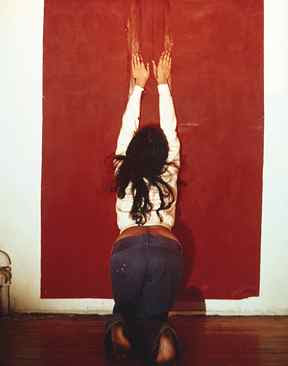
Ana Mendieta was a Cuban performance artist who lived in New York in the 1970’s. The title Where Is Ana Mendieta, not only refers to the suspicious circumstances of her death, but to the nonexistent presence of the work of women artists in mainstream exhibitions, to the absence of work that portrays the aesthetic rooted in Latino cultural identity.
Mendieta boldly explored women’s identity, sexuality, and spirituality in pieces that were deceptively simple. Her work was constructed from the elements themselves, dirt, water, and light in their most basic forms; her themes revolved around the ideas of burial, rebirth, submersion in the natural world. From a perspective beyond the dominant culture's construct of nation, a construct of governments, the hegemony of conquerors, Mendieta's work reverberates with a older, indigenous idea of nation. It challenges the viewer to envision an idea of nation and identity based on a direct relation to the Earth itself.
In a series entitled Tree of Life, Mendieta flattened herself against a large oak tree. She is naked, covered with gesso and paint to simulate tree bark. Where does the tree stop and Medieta begin? Where do we stop and our connection with nature begin? Simply done and deeply resonant. I immediately saw a connection between this piece and a Mexican/Chicano idea of rootedness to place that is not hemmed by borders, but by history and ancestral links to land, to nature itself.
In another, untitled series, Mendieta is shown in a series of photos. Again, she is naked, this time in an isolated field. Next to her is a skeleton. The photos show her climbing onto the skeleton, embracing it. She creates a powerful image of the life/death cycle, as well as a quintessential Latino commentary on mortality. At the heart of existence, life and death are united in an eternal embrace. In the midst of life, its fullness, its lushness, its sensuality, Death is constant companion. While modern, European-based culture constantly seeks to avoid aging and mortality, there are traditions that accept its centrality. Mendieta brilliantly illustrates that death is both the beginning and endpoint of all things.
Mendieta worked closely with a variety of feminist artists, but did not label herself as feminist, and I understand the reticence in using the label. The women's artistic community did not offer a truly supportive relationship, and while she had meaningful connections with individual artists, her work was not be adequately appreciated by feminist and post-feminist critics. In a nutshell, Mendieta did not invent a new relationship to body and Earth, she reclaimed an ancient one, but was never embraced by the 'larger' artistic community.
I was profoundly moved by her work. The work is poetry, visual poetry, poetry made flesh. These are clear, visceral, and direct images that I hope to use as a touchstone in my writing and performing, particularly in performing. I want to tell a personal and universal story with my body, and Mendieta has created a standard for me, as well as strengthening and deepening a physical lexicon.
Blocker’s writing is dry and extremely formal, making this difficult going as a reader, but don't be dissuaded by that. I wonder if some of the density of language was more an expression of Blocker's own inability to grasp and express the power and simplicity of Mendieta. However, the book sings when Blocker allows the work to speak for itself.
ISBN-10: 0822323249
ISBN-13: 978-0822323242
xxxxxxxxxxxxxxxxxxxxxxxxxxxxxxxxxxxxJane Blocker is a specialist in contemporary art and critical theory. She offers courses such as Art Since 1945, Contemporary Art, Alternative Media: Video, Performance, and Digital Art, as well as courses on gender and sexuality, and 20th century theory and criticism.
Her research has focused primarily on performance art as it developed concurrently with postmodern, feminist, and constructionist theories. Her first book, Where is Ana Mendieta? Identity, Performativity and Exile (Duke University Press, 1999), considers the artist's work in relation to the performative production of identity. What the Body Cost: Desire, History, and Performance. (Minneapolis: University of Minnesota Press, 2004), her second book, critically examines the historiography of mid-twentieth century performance. Her current book, called Seeing Witness: Essays on Contemporary Art and Testimony, examines the witness as a privileged subject position by analyzing installations, performances, photographs, and films by such artists as Alfredo Jaar, James Luna, Eduardo Kac, Christine Borland, Felix Gonzales-Torres, and Ann Hamilton.
In addition, she has published the following essays: "This Being You Must Create: Transgenic Art and Seeing the Invisible," Cultural Studies 17, no. 2 (2003): 192-209; "A Cemetery of Images: Meditations on the Burial of Photographs," Visual Resources XX, no. 2 (May 2004) ; "Binding to Another s Wound: Of Weddings and Witness," in After Criticism: New Responses to Contemporary Art, edited by Gavin Butt. (London: Blackwell, 2005); "Failures of Self-Seeing: James Luna Remembers Dino," Performing Arts Journal XXIII, #1 (January 2001):18-32; "The Art of Renters," in From Your House to Our House, exhibition catalogue (Atlanta: Nexus Contemporary Art Center, 1999); "Woman-House: Architecture, Gender and Hybridity in What's Eating Gilbert Grape?," in Camera Obscura 39 (November 1998):126-150; "Ana Mendieta and the Politics of the Venus Negra," in Farquhar, et al, eds. (Un)fixing Representation, special issue of Cultural Studies 12, #1 (January 1998):31-50; "The Bed Took Up Most of the Room," in Peggy Phelan and Jill Lane, eds., The End(s) of Performance (New York: N.Y.U. Press, 1997); and Nancy Spero/Leon Golub: Contemporaries, exhibition catalogue (Detroit, MI: Wayne State University, Elaine L. Jacob Gallery, 1997).
Lisa Alvarado

By: Lisa Alvarado,
on 8/22/2007
Blog:
La Bloga
(
Login to Add to MyJacketFlap)
JacketFlap tags:
dance,
non-fiction,
feminism,
danza,
social commentary,
women's studies,
social change,
political art,
Latina performance,
Antonio's Gun,
Sam Quinones,
Add a tag
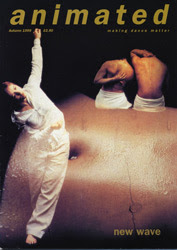
Christy Adair is a freelance writer and cultural critic, contributing to such dance journals as Spare Rib and Everywoman. Women and Dance: sylphs and sirens (Macmillan, 1992), is a text used on dance and performance courses in Britain, America and Asia. Adair contributes reviews and articles to journals, magazines, radio and television both nationally and internationally. She also facilitates a range of performance and education events. Adair is a Reader in Dance Studies at York St John University and is committed to radical performance which communicates an exhilaration of moving and challenges social contexts. Christy has significant links with the dance performance industry both locally in the UK and internationally. Her current research interests focus on gender and ethnicity in relation to dance studies and performance. Her forthcoming book is entitled Dancing the Black Question: The Phoenix Dance Company Phenomenon.
In Women and Dance, Adair introduces the reader to an analysis of Western dance from the point of view of gender and post-feminist analysis. Despite the traditionally high profile of women as principal dancers, Adair asserts that modern Western dance is far from a woman-centered medium. Due to the lack of women choreographers and directors, the genre’s vision of women continues to be rooted in patriarchal notions of the female. It is a representation of the female body that is seriously limited, still unable to reflect the depth of women’s reality.
Adair sees the most synchronous images of women having their origins in dance/performance companies that evolved as in the period post 1970. According to Adair, these groups reflected the fluid, politically progressive images of women following the last wave of the feminist movement. Their major contribution was the development of a type of performance that pushed the boundaries of gender and sex-role expectations. In a piece entitled She Is Giving Birth to Herself, Adair describes how the group Bush Mama explores the primacy of woman relating to other women, not woman-as-male-love-object.
The most useful portion of the book was: “The subversives...women’s dance practices.” It underscores Adair's central tenet that images of women will only be expanded with women themselves taking control of developing, directing, and mounting their own work. This, according to Adair, must occur despite the social and economic barriers involved.
This is particularly potent for me as I try to work more on dance and spoken word pieces. I came to the same realization over the last ten years that I needed to do whatever was necessary to control my own work, how it was showcased, etc. It's also an opinion I've shared with other writer/performers, such as Tara Betts and Sharmili Majmudar, as well as initial discussions with dramaturg and performer Coya Paz, founding member of Teatro Luna here in Chicago.
My only two hesitations in recommending Women and Dance are these: it's an extremely dense read, which made for laborious, although worthwhile reading, and that the book is expensive and better gotten through library sources. But simply put, Women and Dance a vital sourcebook for women performers across the board.
- ISBN-10: 0814706215
- ISBN-13: 978-0814706213
xxxxxxxxxxxxxxxxxxxxxxxxxxxxxxxxxxxxxxxxSpeaking up about immigration ---
Sam Quinones's new book ANTONIO'S GUN AND DELFINO'S DREAM,
a book of vignettes on immigration that has been lauded in the San Francisco
Chronicle, Los Angeles Times, Publishers Weekly, and Library Journal,
as well as having been featured by La Bloga's Daniel Olivas.
Quinones has spoken about immigration--indeed a hot topic again as
Homeland Security begins cracking down on companies that hire
"illegals"--on NewsHour, NPR, and CSPAN.
The newest feature of Sam's website, www.samquinones.com is a link
where the public can tell their "True Tale," the name of which taken
from Sam's first book, TRUE TALES FROM ANOTHER MEXICO.
Here's the link, which has five or six stories from people on it.
http://www.samquinones.com/other_stories.asp
Lisa Alvarado

By: Lisa Alvarado,
on 8/15/2007
Blog:
La Bloga
(
Login to Add to MyJacketFlap)
JacketFlap tags:
theater,
women of color,
women's studies,
LGBT,
T,
Latina performance,
performance art,
women and performance,
Teatro Luna,
Tianguis,
multicultural literature,
Add a tag
 Coco Fusco
Coco Fusco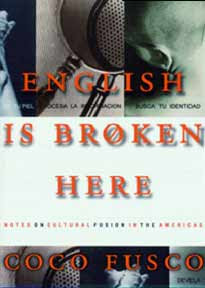
In this series of essays,
Fusco concentrates on examining the work of Latino/a performance artists born in the U.S., and the themes of “otherness” and culture clash. Performers such as Andres Serrano, Laura Aguilar, and
Fusco’s longtime collaborator, Guillermo Gomez-Pena, are held up to the light for close consideration.
In the essay targeting her collaboration with Gomez-Pena, she details a performance done in public venues (museums, municipal buildings) where she and Gomez-Pena created a living exhibit, posing as “specimens” of a fictional indigenous tribe. They displayed themselves in a cage, with dress and talismans gleaned from Pan-Latino/a and popular culture. Her commentary on the experience, on being the observed ”other,” and what she saw as the fascination of the predominately Anglo audience as observer, underscored the themes of objectification and the blurring of public and private.
I had mixed feeling in reading about this performance. On the one hand, I think it was a bold and important artistic move to skewer the dominant culture's idea of 'preservation' and '
curation ,' to challenge it as a kind of pandering to that culture's fascination with they perceive as the 'exotic' indigenous. Never mind that in many cases, these exhibits are only possible as a direct result of colonialism, genocidal practices, and grave robbing. How different is
Fusco's and Gomez-Pena's living exhibit behind bars from the guided tours held on the the
rez, or in barrios, in farm worker camps?
I wonder to what extent the audience grasped that under the rubric of "Latino," there exists hundreds of complex societies, with a heterogeneity of language, practices, rituals. I'm concerned that the work only engenders the knee-jerk, superficial shudder of guilt in primarily white, middle-class audiences.
In the post-performance discussions of
Housekeeper's Diary, the comments from some middle-class people reveal discomfort and their own lack of knowledge as to how to even treat their own maids in a more real, humane way. But there are also comments about what is the vitality and vibrancy of working people--comments about the inherent dignity they sense, despite an external objectification. This, to me is the kind of dialog and engagement I find most satisfying as a performer.
While those points of divergence are significant, I felt I had read something that will challenge me to keep thinking about the political context of performance. One last reservation with this book was
Fusco’s tendency make referential comments about to different artists, without always placing them in context. This can make for a limited appreciation of the the work as a whole, as well as perpetuate an unfortunate tendency of performance artists conversing amongst themselves. (Particularly since
Fusco plumbs the legacy of imperialism, colonialism in her work, it strikes me as odd that she gears her writing to the art intelligentsia. ) It's a challenge, however, worth the effort of cross-referencing and research for the reader.
ISBN-10: 1565842456
ISBN-13: 978-1565842458
xxxxxxxxxxxxxxxxxxxxxxxxxxxxxxxxxxxxxxxx
Una Notita Del Teatro Luna (A Note from Teatro Luna)
Teatro Luna has a VERY exciting show opening in early November. It is called
Machos, and it is based on interviews with 50 diverse men nationwide. Our ensemble members will be performing as men (we have a movement coach and everything) talking about their lives, their work, and, of course, women. If you'd like to bring a group of students to see the show, please contact
[email protected]. We'd be happy to arrange a group rate, a post-show discussion, or even a classroom visit.
Volunteers Wanted!!!
We desperately need volunteers to help us transcribe the last few interviews. Transcription is a time-consuming, tedious process, but nothing could help us more as we work to finalize our script. We're looking for people who can dedicate 10-12 hours in the next week - a lot of ask, we know! In exchange, we will offer you your choice of $50, 4 tickets to
MACHOS, or 2 VIP tickets to a
MACHOS special event. And of course, a thank you in the program and our undying love. Well, at least MY undying love. I can't speak for everyone. if this sounds like something you can commit to, please e-mail Belinda at
[email protected].
Oye-Listen! Call for Submissions for September & November
So far,
OYE-LISTEN! - a new collaboration between
Teatro Luna and Jane Addams Hull-House Museum- has been a blast. Our June and July series had packed houses and vibrant performances from Yolanda Nieves, Sandra Santiago-Posadas, Lani Montreal, Francis Allende-Pellot, Gesel Mason, Toni Asante Lightfoot, Anida Yoeu Ali, Cristal Sabbagh, Andrea Wukitsch, Keiko Johnson and more. There's still time to join the fun! We are currently seeking performers for slots in September and November.
For submission guidelines or questions, please email to
[email protected].
Proyecto Latina - AUGUST 20thThe next
Proyecto Latina is on Monday, August 20th @ 7 p.m. Our August feature is Stephanie Gentry-Fernandez, she shares from her collection of poems. As always there will also be Chisme box and open-mic . Free. Join us at
Tianguis, 2003 S. Damen.
Stephanie Gentry-Fernandez A native of Chicago's South Side, has been involved with a number of organizations including
Teatro Luna, About Face Theater, and el
Cafe Teatro Batey Urbano. Stephanie has facilitated journaling and poetry workshops for young incarcerated women and adult female survivors of domestic violence. She moved back home to Chicago after a two and a half year stint in the hippy Bay Area. Her work addresses issues like anti-oppression, survival, healing, and hope. Stephanie is currently working as Associate Director of the Chicago Freedom School.
About Proyecto Latina:
Proyecto Latina is a collaborative between
Teatro Luna,
Tianguis, and
Mariposa Atomica Ink. We are excited about showcasing Latina talent and are always seeking outgoing Latina poets and performers for our monthly open mic series.
Proyecto Latina takes place the third Monday of every month. Its an open mic so everything's game: Poetry, spoken word, music, monologues, shorts y en el idioma que prefieras. And if you're too shy to get on stage come and be one of the lucky spectators.
Teatro Luna Upcoming Season!Get ready for a whole year of
Teatro Luna! We have three brand new shows coming up.
Machos, a new ensemble performance based on interviews with men nationwide, opens November 8th.
Solo Tu, a collection of four solo plays about four very different women, opens February 28, 2008.
Restaurant Spanish, an ensemble play about immigration and communication, opens late summer (dates TBA).
Visit us at
www.teatroluna.org or
www.myspace.com/teatrolunaLisa Alvarado
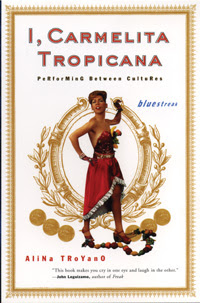
I, Carmelita Tropicana: Performance Between Cultures
Hello people, you know me, I know you.
I am Carmelita Tropicana.
I say Loisaida is the place to be. It is multicultural, multinational, multigenerational, mucho multi.
And like myself , you've got to be multilingual.
I am very good with the tongue.
"This book makes you cry in one eye and laugh in the other."
-John
Leguizamo, author of
Freak"Alina
Troyano's one-woman shows, plays, and essays have astonished audiences and readers with their creativity, humor, and crackling political energy. I, Carmelita Tropicana offers the first comprehensive collection of her work, from "
Memorias de la
Revolución" (with Uzi
Parnes) to "Your
Kunst is Your
Waffen" (with
Ela Troyano).
"The writing in this wonderful book is like
café Cubano: rich, strong, satisfying." -Steve
Buscemi"Dwellers of the Lower East Side have long known of the magic they call Carmelita Tropicana. Carmelita and her comrades-in-arms teach us that humor can have a subversive edge and that politicized performance can be hilarious. This book is a triumphantly tacky treasure trove of tropical delights." -
José Esteban
Muñoz, author of
Disidentifications"The inimitable Carmelita Tropicana is one of the queer world's wonders: sexy, outrageous, and insightful, her performances transform rooms full of strangers into communities of lovers, friends, and admirers."-Jill
Dolan, author of
Presence and Desire"Laughter is
Troyano's weapon, and she wields it expertly to send up stereotypes like the Latina spitfire and to push the limits of rigid identities. This long-awaited book will be a boon in any classroom studying performance, as well as in racially and gender-inflected queer and cultural studies." -Yvonne
Yarbro-
Bejarano, editor of
Chicano Art: Resistance and Affirmation, 1965-1985Alina
Troyano, Cuban-born writer and performance artist, is the recipient of a 1999 Obie award for Sustained Excellence of Performance, and named by
el Diario as "
una de las mujeres mas
destacadas de 1998." She has presented her work nationally and internationally in both English and Spanish.
As a writer she has distinguished herself since 1985, when she was selected to participate in
Intars musical Theatre Labs under the direction of Graciela Daniele and George
Ferrencz.
She has received fellowships from the New York Foundation for the Arts for Performance Art, as well as for screenwriting and
playwriting. She has received a
CINTAS Foundation fellowship for her literary work, as well as a 2001 writing fellowship from The Mark Taper Forum, a 2002 writing fellowship from the Cuban Arts Foundation, and in 2003 the Plumed Warrior writing award from
LLEGO, a National Latin Gay Lesbian Bisexual Transgender Organization.
In 2000, Beacon Press published
I, Carmelita Tropicana: Performing Between Cultures, a Lambda Award nominee for theatre. In the opening quote in this article, Alina is speaking as her Latin-bombshell persona, Carmelita.
Troyano has sampled the 'exotic other' archetype of Carmen Miranda, and put a queer, radical aesthetic spin to her. Hardly the palatable fantasy of the easy-conquered, not-too-bright Carmen.
This is a book that made me laugh out loud. It is part “diary”, part monologue, part cultural commentary by one Carmelita Tropicana, a.k.a. Alina
Troyano.
Troyano is a Cuban lesbian performance artist whose work skewers racial, cultural, and sexual stereotypes. Carmelita is my new patron saint.
In the preface there is a reference to
Troyano's use of 'innuendo, bilingual puns, double
entendre, burlesque, parody, political farce, biographical revisionism, and an irreverent appropriation and
collaging of popular culture.' She draws text from popular movies, past stereotypical icons, and popular music. While the style is irreverent, her themes are hardly light. In placing expropriated material in another context, it becomes reinvented, with layers of new meaning and ultimately a critique of the original manifestation itself.
In a piece entitled
Your kunst ist your waffen, Carmelita/Alina pokes fun at performance art and sexual stereotyping. In a monologue to the audience, she explains how a “fairy” godmother told her it was her destiny to sing and dance in the tradition of Carmen Miranda. The vaguely sexual title of the piece conjures up images of lesbian sex. In reality, it translates to ”Your art is your weapon.”
She goes on, in a fictitious diary, to satirize Castro, boat people, Catholicism, traditional ideas of Latina femininity and family life. In her “diary”, Carmelita/Alina reveals that as as prison entertainer, she saw a group of nuns behind bars singing a rancher song entitled:
Prisoneros de Amor/Prisoners of Love. I admired and enjoyed
Troyano’s brashness, her satiric wit, and her willingness to take the starch out of some of our (Latin) sacred icons. There is also an inherent political act in lifting, deconstructing and
revisioning elements of popular culture in this way.
To better illustrate her work and style, I want to close with an excerpt from her performance at New York's New Museum of Contemporary Art.
Recipe for Carmelita's Bad Girls Show at the New Museum of Contemporary Art.
INGREDIENTS
1/3 Pingalito (Carmelita in male drag) recites
"Ode to the Cuban Man" from Milk of Amnesia
1/3 Carmelita delivers Performance Art Manifesto (which varies based on the audience, how Carmelita feels at any given moment, and the venue.)
1/3 The Art Quiz Show
HOW TO MAKE THE ART QUIZ SHOW
Sprinkle clues for the audience to guess the artwork
or artist recreated in live tableaux.
Add pinch of art commentary to taste and blend with 1 generous dollop of modern dancer Jennifer Monson (collaborator) whisked rapidly for Duchamp's Nude Descending a Staircase. Set aside.
IN A SEPARATE PAN MIX
1/2 cup Jennifer as Cupid with piercing arrow and 1/2 cup Carmelita moaning, hanging on museum fire escape.
Simmer to Wagner's Tristan und Isolde and stir until both harden into Bernini's sculpture The Agony of St. Theresa.
For skewering performance art's often ponderous images and general pomposity, and for giving queer aesthetics a decidedly Latina sabor....Que Viva Camelita!
ISBN: 0807066036
Lisa Alvarado

By: Lisa Alvarado,
on 5/23/2007
Blog:
La Bloga
(
Login to Add to MyJacketFlap)
JacketFlap tags:
storytelling,
theater,
feminism,
women of color,
women's studies,
Latina performance,
women and performance,
Teatro Luna,
sex positive,
Add a tag

Teatro Luna was founded in June 2000 by Coya Paz and Tanya Saracho, with an original ensemble of ten women from diverse Latina/Hispana backgrounds. We came together because we realized that the stories and experiences of Latina/Hispana women were undervalued and underrepresented not only on the Chicago stage, but beyond.
Many of us had similar experiences of being asked to perform stereotyped images of ourselves that were often one-dimensional and, at times, offensive: spicy sexpots, voiceless maids, pregnant gangbangers, timid "illegal" immigrants, etc. We were also concerned that the few parts written for Latina women often went to non-Latina actresses. We felt that we had to do something. Our answer was Teatro Luna, Chicago's first and only all-Latina theater.
xxxxxxxxxxxxxxxxxxxxxxxxxxxxxxxx
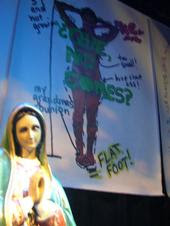
Teatro Luna, Chicago’s only all-Latina Theater company is pleased to announce the world premiere of LUNATIC(a)S, a new play about women’s everyday insanity.
LUNATIC(a)S
From Chicago-style road rage to an obsession with catching muggers, LUNATICAS uses Teatro Luna’s trademark humor and honesty to tell a truth we don’t always want to tell: Sometimes, we’re just a little bit crazy.
Directed and developed by award-winning playwright Tanya Saracho,
LUNATIC(a)S tackles Teatro Luna’s namesake The Moon (La Luna) and places our true-life stories in the context of myths and superstitions about women, Latinas, and the moon.
LUNATIC(a)S follows Teatro Luna’s critically acclaimed shows Quita Mitos and S-e-x-Oh!, bringing a range of Latina stories to light. Reimagining the Mayan goddess lx Chel as a modern day urban Latina, LUNATIC(a)S moves from the mythical (the moon is always female) to the serious (violent mothers) to the tragically hilarious (the slow slide from jealous girlfriend to bonafide stalker). As always, Teatro Luna is cheeky, straightforward, and willing to tell even the most outrageous secrets about our Latina lives.
Where: Chicago Dramatists, 1105 W. Chicago, Chicago, IL
When: PREVIEWS: June 1st, 2nd and 3rd 2007 || OPENING: Thursday June 7th, 2007 || RUNS FROM: June 7th to July 15, 2007 (Thursdays @ 7:30pm, Fridays and Saturdays @ 8pm, and Sundays @ 3pm)
Who: PERFORMED: by Belinda Cervantes, Maritza Cervantes, Gina Cornejo, Yadira Correa, Miranda Gonzalez, and Suzette Mayobre. DIRECTED AND DEVELOPED BY: Tanya Saracho
How Much?: PREVIEWS: $10, $7 Students (ID required) || GENERAL: $15, $10 Students (ID required), Groups of 8 or more, $12
For Reservations: Call 773-878-LUNA
For more information visit: www.teatroluna.org
As all Teatro Luna shows, LUNATIC(a)S is performed in English with a sprinkle of Spanish.
Important note: This show features frank discussion about intimate topics as well as images of real women’s bodies and may not be appropriate for younger audiences.
About Teatro Luna:
Teatro Luna is Chicago’s first and only all-Latina theater ensemble dedicated to creating work that showcases the talents of Latina/Hispana artists. Founded by Tanya Saracho and Coya Paz in 2000, Teatro Luna is dedicated to expanding the range of Latina/Hispana roles visible on the Chicago stage and beyond. Previous shows include Generic Latina, Dejame Contarte, Kita y Fernanda, The Maria Chronicles at Theatre on the Lake, and Solo Latinas at Chicago Dramatists. In addition, Teatro Luna is frequently asked to bring their trademark blend of ensemble performances to theatres, universities and festivals across the county. www.teatroluna.orgxxxxxxxxxxxxxxxxxxxxxxxxxxxxxxxx
Teatro Luna announces auditions for our fall run of MACHOS, an interview based project drawn from conversations with men all across the country.
We are looking for Latina/Hispana performers of all ages who are comfortable and able to play MEN. Previous performance experience is a plus, but not mandatory.
Performers must be able to commit to the following dates:
Performances Thursdays through Sundays,
November 1-Dec 15th.
Rehearsals Tuesdays, Wednesdays, and Sundays
starting September 4th.
Performance/writing workshops twice a week (TBD)
June 15-July 15th
Auditions for Machos will be held June 2nd, between 10am and 2pm. To schedule an audition, please e-mail
[email protected] with your preferred time (15 minute slots) and a phone number where you can be reached.
To audition:
-Please come dressed to show us that you can perform as a man. We are looking beyond the stereotypes, so whatever that means to you! (There is a changing room available if you would like to change before or after your audition.)
-Please prepare a short (1-2 minutes MAX) original piece - it can be a joke, a story, some chisme, a monologue, a poem, lo que sea - we just want to get a sense of what you have to say and how you say it! Pieces should be memorized if possible.
-Please bring a recent headshot or photo, and a copy of your resume.
Teatro Luna is Chicago's first and only all-Latina theater company. Visit us on the web at
www.teatroluna.org and don't miss our upcoming show Lunatic(a)s, playing June 1-July 15th at Chicago Dramatists.
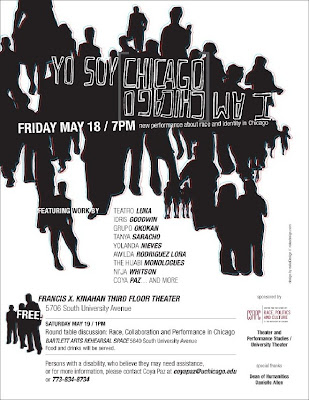
Yo Soy Chicago/I Am Chicago
New performance about race and identity in Chicago, curated by Coya Paz of Teatro Luna and sponsored by the Center for The Study of Race, Politics, and Culture.
From a gun-toting apparition of the Virgin Mary to a humorous drag take on Puerto-Rican identity to the real life stories of young Muslim women, I Am Chicago/Yo Soy Chicago brings together Chicago's most vibrant performing artists to explore race and identity in Chicago. I Am Chicago/Yo Soy Chicago is a multimedia celebration of Chicago's culturally and aesthetically diverse performing arts communities.
Yo Soy Chicago/I am Chicago
featuring work from Teatro Luna, Idris Goodwin, Ni'ja Whitson, Grupo Okokan, Tanya Saracho, Yolanda Nieves, Awilda Rodriguez Lora, the Hijabi Monologues and more.
Francis X. Kinahan Third Floor Theater
5706 South University Avenue
sponsored by:
The Center for the Study of Race, Politics, and Culture
Theater and Performance Studies / University Theater
Lisa Alvarado












My alarm clock confuses me, too. The designers decided to pepper the surface with buttons I must absolutely not touch.
Oh wow, I just realized that that’s why I have trouble with locks too. Weird.
Sad thing is, it’s still faster to move coloured pieces of paper between counters than it is to do e-banking transfers.
good stuff. the one about the car clock cracks me up. I just do a quick mental calculation when i need to know the time (its off by 50 minutes). I probably spend more time doing the math, then if I would just open the glove box and look at the instructions just once.
good to know that even the library-queen of cool has tech issues.
I got rid of my answering machine and kept Caller ID. I much prefer knowing who called. I can find out what they had to say if I opt to call them back. Besides, anyone who really needs to talk to me knows to IM or email.
Like a lot of people I have no television, but I do have a nice
7” screen DVD player.
I’m also old fashioned enough to use a nice old fashioned
windup alarm clock.
One of my recent achievements was to get a new stylus for
my 15 year old record player.
On the other hand I used to use an old fashioned duplicator
in order to produce newsletters & leaflets in my younger
days. They were time consuming & very dirty machines to
operate, & I’d hate to have to use them again, even if I can
become very nostalgic about such items.
There is a friend of mine who runs a couple of websites, &
who uses only open source software. He too does not own a
television or radio.
He also gets most of his news via email.
All of which shows just how much of a technological mix &
match we now all have.
For your car clock, just disconnect the battery and re-connect it at noon or midnight. Wa-lah! Of course, you then lose all your radio station pre-sets, but you know how to that again don’t you?
Sorry if this gets through, Jessamyn, just testing your comment Challenge plugin. I have to do something to cut down on my comment spam.
I’m with you on all those unnecessary cell phone features… but the magic of direct deposit is pretty sweet.
“Mailing paychecks”?
Is that common in the US? Your employer doesn’t just deposit straight into your bank account? I don’t think I’ve had a paycheck in over a decade…
Reading the rest of your post, I’m going to hunt you down on Facebook and lose to you at Scrabble. With you on e-books and podcasts, but I love my iPod. I don’t even drive (how’s that for a tech-NO?)
[…] tech-NOs: http://www.librarian.net/stax/2253/my-tech-nos/ « előző | Takács Dániel — 2008. 03. 02. […]
Note to Simon (comment 10): I think Jessamyn has a number of different employers (she’s a consultant), so I doubt that direct deposit is available to her in all cases.
Nevertheless, it’s amazing to me how many of my (full-time, one employer) co-workers don’t take advantage of direct deposit.
I can’t set the time on the clock in my car and it’s set to some crazy time [i.e. not like an hour or two off]. I’d like to, but this time of year if I’m not driving the car it’s too cold to be in it. Erica?
–> It took me about 20 minutes to figure out how to change the clock in my car when it was daylight savings times. Setting car clocks is not very intuitive and every car is very different.
My bank is in Washington state. While I do a lot of e-banking with them, I generally mail my paychecks to my bank to deposit them. This isn’t strictly technological in nature, but it’s definitely an old-fashionedness that looks like a tech-not.
–> I direct deposit all my checks, in fact my company requires it.
I can barely use my cell phone. I can take a picture. I can make and receive phone calls. I can text, but I still try to answer it when someone is text messaging me. I like to think I’d be a better study if the thing worked in my house.
–> I use my cell phone to make calls. That’s it. I know my cell phone has other features like a calculator and games but I never use them. I read my text messages but I have yet to send one to anybody. I still use email for that.
I have very little e-book curiosity. My interest in e-books is purely professional.
–> I prefer the traditional book format but will consider e-books if its a book I don’t want to buy and its not available in the library.
I have an iPod I rarely listen to. I have an iPhone I don’t use much (both were gifts). I like to have them, but I usually just listen to the radio in my car and iTunes on my laptop at home.
–> I don’t have an iPod but have an MP3 player that does a similar thing. I listen mainly to CDs in the car but use the MP3 player when working out.
I have created more podcasts than I have listened to.
–> You’re one up on me there. I wouldn’t have a clue how to create a podcast. I have downloaded a few, mainly just to say that I could do it.
I don’t play online games much. I play Scrabulous (come find me on facebook!) and that’s pretty much it. When you have a job that’s online, spending more time there just doesn’t seem as appealing.
–> The only computer games I play are Minesweeper and Solitaire.
I use my TV to watch movies only, and even then pretty rarely. I was a Nielsen family earlier in the month and I sent the whole book back blank.
–> I hardly ever watch TV, maybe a couple hours a month. I mainly use my TV to view DVDs.
I don’t have voice mail, just an answering machine. No caller ID, so please tell me who you are when you call.
–> I don’t have caller ID either because I didn’t want to pay the extra money. I don’t have voice mail either, just an answering machine.
When I have to set the alarm to wake up, which happens rarely, I’m as likely to set it for PM as for AM. This is more of an absentminded professor thing than a tech-NO, but I’ve sortof never gotten the hang of setting an alarm on something without hands
–> I usually don’t have problems getting an alarm clock but I will too, set it for PM instead of AM once in a while.
And lastly, because I grew up in the country, I pretty much don’t understand locks. I have a heck of a time with any door that locks, remembering which direction to turn the key, or rememebring my keys period.
–> I have a lot of problems with this too. Every lock is different. Some you have to turn right to open; others its left. If they were made more uniform, it would be a lot easier.
I don’t have a cell phone or call display. I’ve had both in the past, but simply don’t need them in my present situation (I live a block from work and have no need for a cell phone for emergencies, and I’m just not a phone person so I don’t call people just to chat much). All the rest - I’m the person people call up or bring things to to figure out how to reset or reattach all the wires. I guess I’m pretty much a tech-yes!